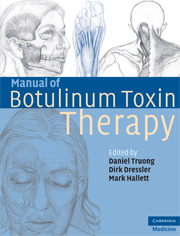Book contents
- Frontmatter
- Contents
- List of contributors
- Foreword – Alan B. Scott
- Preface
- 1 The pretherapeutic history of botulinum toxin
- 2 Botulinum toxin: history of clinical development
- 3 Pharmacology of botulinum toxin drugs
- 4 Immunological properties of botulinum toxins
- 5 Treatment of cervical dystonia
- 6 Treatment of hemifacial spasm
- 7 Treatment of blepharospasm
- 8 Treatment of oromandibular dystonia
- 9 Treatment of focal hand dystonia
- 10 Botulinum toxin applications in ophthalmology
- 11 Botulinum toxin therapy of laryngeal muscle hyperactivity syndromes
- 12 The use of botulinum toxin in otorhinolaryngology
- 13 Spasticity
- 14 The use of botulinum toxin in spastic infantile cerebral palsy
- 15 Hyperhidrosis
- 16 Cosmetic uses of botulinum toxins
- 17 Botulinum toxin in the gastrointestinal tract
- 18 Botulinum toxin in urological disorders
- 19 Use of botulinum toxin in musculoskeletal pain and arthritis
- 20 The use of botulinum toxin in the management of headache disorders
- 21 Treatment of plantar fasciitis with botulinum toxin
- 22 Treatment of stiff-person syndrome with botulinum toxin
- 23 Botulinum toxin in tic disorders and essential hand and head tremor
- 24 Developing the next generation of botulinum toxin drugs
- Index
- References
7 - Treatment of blepharospasm
Published online by Cambridge University Press: 28 July 2009
- Frontmatter
- Contents
- List of contributors
- Foreword – Alan B. Scott
- Preface
- 1 The pretherapeutic history of botulinum toxin
- 2 Botulinum toxin: history of clinical development
- 3 Pharmacology of botulinum toxin drugs
- 4 Immunological properties of botulinum toxins
- 5 Treatment of cervical dystonia
- 6 Treatment of hemifacial spasm
- 7 Treatment of blepharospasm
- 8 Treatment of oromandibular dystonia
- 9 Treatment of focal hand dystonia
- 10 Botulinum toxin applications in ophthalmology
- 11 Botulinum toxin therapy of laryngeal muscle hyperactivity syndromes
- 12 The use of botulinum toxin in otorhinolaryngology
- 13 Spasticity
- 14 The use of botulinum toxin in spastic infantile cerebral palsy
- 15 Hyperhidrosis
- 16 Cosmetic uses of botulinum toxins
- 17 Botulinum toxin in the gastrointestinal tract
- 18 Botulinum toxin in urological disorders
- 19 Use of botulinum toxin in musculoskeletal pain and arthritis
- 20 The use of botulinum toxin in the management of headache disorders
- 21 Treatment of plantar fasciitis with botulinum toxin
- 22 Treatment of stiff-person syndrome with botulinum toxin
- 23 Botulinum toxin in tic disorders and essential hand and head tremor
- 24 Developing the next generation of botulinum toxin drugs
- Index
- References
Summary
Clinical features and pathophysiology
Primary blepharospasm is a common adult-onset focal dystonia, characterized by involuntary contractions of the periocular muscles resulting in forceful eye closure, and impairing normal opening and closing of the eyes (Marsden,1976; Berardelli et al., 1985). The severity of blepharospasm can vary from repeated frequent blinking, causing only minor discomfort, to persistent forceful closure of the eyelids leading to functional blindness (Figure 7.1). Blepharospasm can be caused by tonic or phasic contractions of the orbicularis oculi muscles and may also be associated with levator palpebrae muscle inhibition (apraxia of eyelid opening) or involuntary movements in the lower face or jaw muscles (Meige's syndrome). In most cases blepharospasm is considered primary and is only occasionally secondary to structural brain lesions or drug induced (Jankovic, 2006).
Neurophysiological recordings of the blink reflex have given important insight into the pathophysiology of blepharospasm. In patients with blepharospasm, the recovery cycle of the R2 component of the blink reflex is enhanced, presumably owing to a lack of brain stem interneuronal inhibition (Berardelli et al., 1985, 1998). Blepharospasm is also associated with an abnormal responsiveness of the blink reflex to sensory stimuli. Recent studies with the technique of magnetic brain stimulation also suggest a loss of inhibition and increased plasticity in the central nervous system of patients with blepharospasm.
Anatomy of the periocular muscles
Knowledge of the anatomy of the upper facial muscles is essential for treating patients with blepharospasm.
- Type
- Chapter
- Information
- Manual of Botulinum Toxin Therapy , pp. 49 - 52Publisher: Cambridge University PressPrint publication year: 2009
References
- 1
- Cited by

